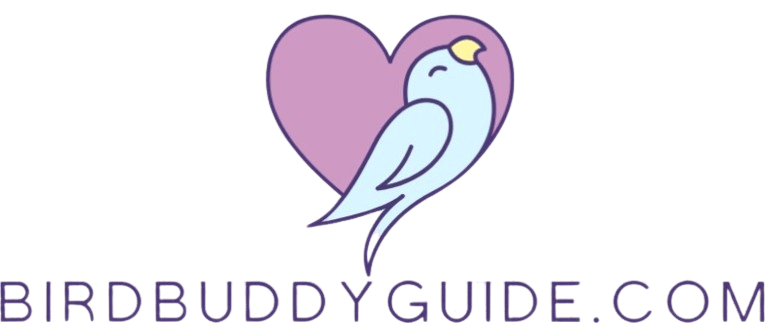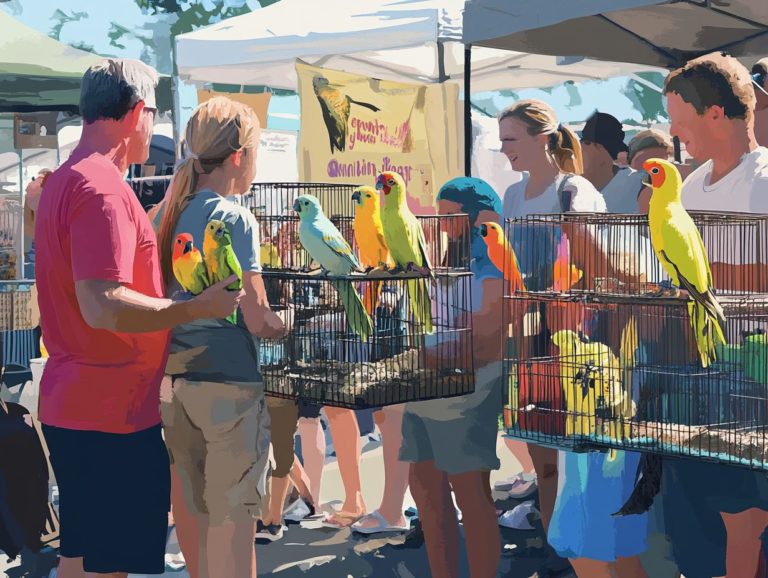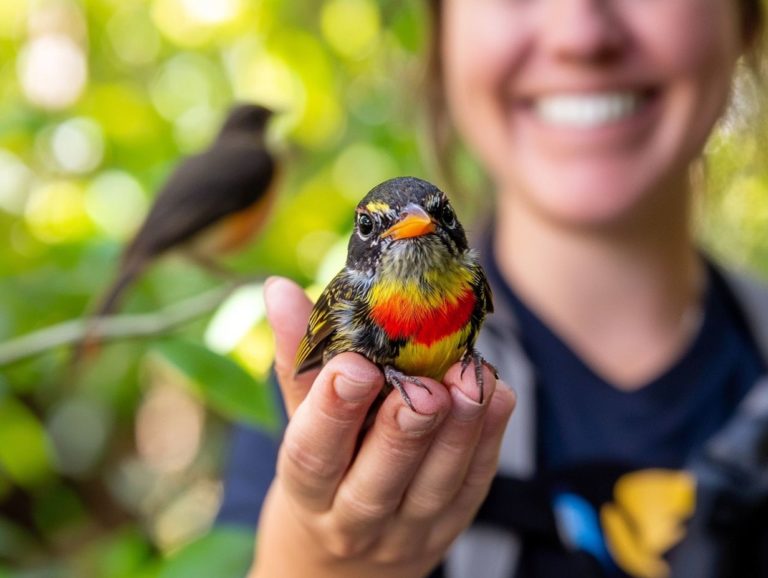How to Report Abandoned Birds for Rescue
Birds are truly captivating creatures that bring joy and beauty to our lives. However, sometimes these feathered friends find themselves abandoned and in need of our help.
To truly help abandoned birds, you need to know what they face. Understanding the causes and types of abandonment is essential for anyone who cares about these lovely beings. This article delves into recognizing signs of distress, guiding you on when and how to report abandoned birds, and outlining the immediate actions you can take while awaiting assistance.
It also addresses how you can prevent abandonment through responsible bird ownership. Together, you and others can create a safer environment for your bird friends.
Contents
- Key Takeaways:
- What You Need to Know About Abandoned Birds
- When to Report an Abandoned Bird
- How to Report an Abandoned Bird
- What to Do While Waiting for Help
- Preventing Abandonment in the Future
- Frequently Asked Questions
- How do I report abandoned birds for rescue?
- What information should I provide when reporting abandoned birds for rescue?
- Can I report abandoned birds for rescue anonymously?
- What should I do if I can’t reach a rescue organization to report abandoned birds?
- Is it legal to take in abandoned birds for rescue on my own?
- What should I do if I come across an abandoned bird nest?
Key Takeaways:

- Spot signs of abandoned birds, like injuries or neglect.
- Report abandoned birds to local animal rescue organizations or authorities to ensure their safety and well-being.
- While waiting for help, provide temporary care and shelter for abandoned birds and promote responsible bird ownership to prevent future abandonment.
What You Need to Know About Abandoned Birds
Understanding the plight of abandoned birds needs awareness of the many factors contributing to their abandonment. Habitat degradation, human intervention, and the absence of natural parents can lead to the unfortunate circumstance of orphaned animals, including baby birds and other wildlife.
Often, these young birds are found in disturbed nests, making them vulnerable and in urgent need of help from trained individuals who assist injured or abandoned animals. Grasping this understanding is vital for the effective conservation and management of wildlife populations, ultimately ensuring their safety and well-being.
Causes and Types of Abandonment
The causes and types of abandonment in birds can vary significantly, influenced by factors from natural events like habitat degradation to human-related issues such as disease transmission or interference with adult animals. Understanding these causes is vital for effective wildlife management and the protection of vulnerable species, especially during critical periods like the nesting season for migratory birds.
Environmental changes, including climate fluctuations and habitat destruction, often disrupt natural breeding cycles, leading birds to abandon their nests. For instance, species like the Black-crowned Night Heron and the Least Tern are increasingly at risk due to rising water temperatures and coastal urbanization. Threats from invasive predators also increase stress levels among breeding pairs, further contributing to nest abandonment.
Human intervention, such as habitat encroachment and pollution, only exacerbates the challenges these bird populations face. This underscores the urgent need for comprehensive conservation strategies that tackle both environmental and human-made issues head-on.
When to Report an Abandoned Bird
Knowing when to report an abandoned bird is essential for wildlife enthusiasts and community members alike, particularly when you notice signs of distress or neglect.
Look for key indicators such as visible injuries, a lack of chirping or response, and an inability to fly. These can all signal that immediate wildlife assistance is necessary.
Act quickly! Your prompt action can save a life. Having access to a wildlife hotline for guidance on your next steps is crucial; your reporting can make a significant difference in the safety and recovery of these vulnerable creatures.
Signs of Distress or Neglect

Recognizing signs of distress in birds is crucial. Specific indicators can alert caregivers and wildlife lovers.
For example, if you see baby birds vocalizing excessively or flapping their wings without any control, it s a clear sign they might need a helping hand. Adult birds may exhibit erratic behaviors, like lingering on the ground or hiding away, suggesting they could be injured or unwell.
You might also notice feathers scattered around nests, indicating a struggle, while drooping wings are a telltale sign of afflictions that require immediate wildlife care.
By understanding these behavior signs, you can significantly enhance your ability to provide timely help, ensuring the well-being of these magnificent creatures.
How to Report an Abandoned Bird
Reporting an abandoned bird requires knowing the right channels to contact. This often includes local animal rescue organizations and wildlife rehabilitators, who are trained professionals equipped to handle such situations.
It’s crucial to adhere to federal regulations concerning wildlife protection. Utilize resources, such as a list of wildlife rehabilitators, to find the proper assistance tailored to the specific bird species in question.
Contacting Local Animal Rescue Organizations
Contacting local animal rescue organizations is vital for addressing the needs of an abandoned bird. These groups can provide the expertise necessary for the situation.
Utilizing a wildlife hotline can offer immediate support and guidance, ensuring that the bird receives the appropriate care while following Texas Parks and Wildlife regulations and recommendations from Audubon Texas.
When you reach out, share specific details about the bird’s condition, such as any visible injuries, its location, and the circumstances of its abandonment. This helps rescuers prepare effectively.
Local rescue groups are vital to the ecosystem. They not only rehabilitate wildlife but also educate the community, fostering a deeper understanding of wildlife conservation.
Reporting to Authorities
Reporting an abandoned bird to authorities, like the U.S. Fish and Wildlife Service, is essential for ensuring that wildlife protection laws are upheld. Recognizing these laws is crucial for protecting wildlife!
Understanding federal law regarding wildlife care helps you report effectively, ensuring that proper protocols are followed to assist these neglected creatures.
These laws, rooted in the Migratory Bird Treaty Act and the Endangered Species Act, require specific actions when encountering wildlife in distress. You have the responsibility to report such cases and should also be aware of the penalties for violating these laws. Comprehending this legal framework empowers you to understand your role in wildlife conservation.
Your involvement raises public awareness about protecting various species and habitats, fostering a community that values biodiversity and embraces responsible stewardship.
What to Do While Waiting for Help

While waiting for help, prioritize the bird’s safety! Providing appropriate temporary care and shelter is essential.
Create a safe, quiet space away from disturbances. Maintain a respectful distance to minimize stress on the animal. When it comes to feeding or watering, follow wildlife assistance guidelines to ensure you re acting in the bird’s best interest.
Providing Temporary Care and Shelter
Providing temporary care and shelter for an abandoned bird is essential for its well-being. This small act can significantly enhance its recovery chances. By creating a safe environment that mimics its natural habitat, you help maintain the bird’s health and reduce stress. This facilitates a smoother transition to professional wildlife care when the time comes.
It s crucial to arrange a quiet, warm space free from disturbances. Consider using a soft, padded container as a temporary nest; it offers comfort while ensuring proper ventilation.
Feeding the bird a specialized diet is vital, as nutrition plays a fundamental role in recovery. Keep a close eye on the bird it s vital for its recovery!
By cultivating an understanding of proper care techniques and seeking assistance from local wildlife rehabilitation professionals, you can create an effective support system for the bird s journey back to health.
Preventing Abandonment in the Future
Preventing future abandonment starts with your commitment to educating yourself and raising awareness about responsible bird ownership and the preservation of wildlife habitats. By utilizing available resources and partnering with conservation agencies, you can play a crucial role in ensuring that bird populations flourish.
This proactive approach not only reduces the risk of orphaned animals but also cultivates a deeper appreciation for wildlife within your community.
Education and Resources for Responsible Bird Ownership
Education and resources for responsible bird ownership are vital for cultivating a community that values wildlife. It s essential to understand the consequences of abandonment. By tapping into various wildlife care programs and collaborating with conservation agencies, you can learn how to support local bird species and promote their well-being.
From engaging online courses to immersive hands-on workshops, there are countless opportunities to enhance your knowledge of taking care of birds. Many organizations offer specialized training that covers essential topics such as nutrition, behavior, and habitat preservation.
Community-driven initiatives invite you to partake in birdwatching, nurturing a culture of conservation that benefits both the avian population and the environment. Resources like informative pamphlets, dedicated websites, and local forums equip you with valuable insights while connecting you with fellow enthusiasts.
Collectively, these endeavors foster a well-informed community that prioritizes the protection and care of birds, ensuring they continue to thrive in nature.
Frequently Asked Questions

How do I report abandoned birds for rescue?
To report abandoned birds for rescue, contact your local animal shelter, wildlife rehabilitation center, or bird rescue organization. You can also reach out to animal control or the police department for assistance.
What information should I provide when reporting abandoned birds for rescue?
When reporting abandoned birds, provide the location and any identifying information such as the type of bird, color, and size. Additionally, consider exploring volunteer opportunities at local bird rescues to help support their care and rehabilitation. Mention if the birds are injured or in immediate danger.
Can I report abandoned birds for rescue anonymously?
Yes, you can report abandoned birds anonymously. However, providing your contact information may help the rescue organization follow up for additional information or updates on the birds’ situation.
What should I do if I can’t reach a rescue organization to report abandoned birds?
If you cannot reach a rescue organization, contact a local veterinarian or animal hospital for assistance. They may provide advice or direct you to appropriate resources for reporting abandoned birds.
Is it legal to take in abandoned birds for rescue on my own?
No, it is not legal to take in abandoned birds without proper permits and training. It s important to contact a licensed rescue organization to ensure the birds receive the care they need.
What should I do if I come across an abandoned bird nest?
If you spot an abandoned bird nest, stay calm and keep your distance! Bird parents often step away to find food for their little ones.
Only take action if the nest is disturbed or the birds are at serious risk. Every moment counts!






